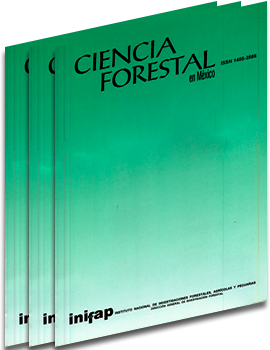EVALUACIÓN DE UNA PLANTACIÓN DE TRES ESPECIES TROPICALES DE RÁPIDO CRECIMIENTO EN NUEVO URECHO, MICHOACÁN
Keywords:
Acrocarpus fraxinifolius, growth assessment, Gmelina arborea, Michoacan, tropical forest plantations, Tectona grandisAbstract
In the state of Michoacan the Commercial Plantation Program began in 2003 and the most planted species are Pinus (69%), Cedrela odorata and Acrocarpus fraxinifolius (24%), Eucalyptus camaldulensis (5%) and 2% of native tropical species. Results about their adaptation and growth in different ecological conditions in the state are unknown. The objectives of this research were to assess the response in height growth, normal diameter and survival of Tectona grandis, Acrocarpus fraxinifolius and Gmelina arborea, as well as to compare the annual mean increment with data from foreign countries. The plantation was established in December 2003 at Nuevo Urecho, Michoacan, where environmental conditions are: chromic vertisol soil, subhumid weather, 3% slope and an altitude of 514 m. A random block experimental design was applied, with three treatments and four replications. Each experimental unit was made up of 25 plants, which summed up 100 for each species. Environmental conditions of the place are: land preparation labor was done prior to the establishment of the plantation, and a fallow at 30 cm deep was done. Additional watering was applied during the dry season. Results showed significant differences in height and normal diameter among treatments after two years, but survival was not different. Gmelina arborea was the species with the best response (6.82 cm in high), BHD of 10.81 cm and a survival percentage of 94.96. This species offers a good potential to develop a commercial plantation program in the dry tropic area of the state of Michoacán.
Downloads
Downloads
Published
How to Cite
Issue
Section
License
The authors who publish in Revista Mexicana de Ciencias Forestales accept the following conditions:
In accordance with copyright laws, Revista Mexicana de Ciencias Forestales recognizes and respects the authors’ moral right and ownership of property rights which will be transferred to the journal for dissemination in open access.
All the texts published by Revista Mexicana de Ciencias Forestales –with no exception– are distributed under a Creative Commons License Attribution-NonCommercial 4.0 International (CC BY-NC 4.0), which allows third parties to use the publication as long as the work’s authorship and its first publication in this journal are mentioned
The author(s) can enter into independent and additional contractual agreements for the nonexclusive distribution of the version of the article published in Revista Mexicana de Ciencias Forestales (for example, include it into an institutional repository or publish it in a book) as long as it is clearly and explicitly indicated that the work was published for the first time in Revista Mexicana de Ciencias Forestales.
For all the above, the authors shall send the form of Letter-transfer of Property Rights for the first publication duly filled in and signed by the author(s). This form must be sent as a PDF file to: ciencia.forestal2@inifap.gob.mx
This work is licensed under a Creative Commons Attribution-Noncommercial 4.0 International license.


